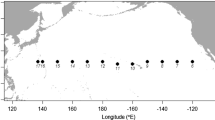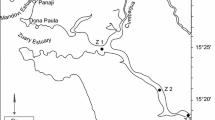Abstract
Zooplankton ingestion of phytoplankton carbon in the iceedge zone of the Eastern Bering Sea was measured using a deck incubation approach in 1982. Using further samples collected in 1983, the plant cell carbon to cell volume ratio was estimated at 0.0604 pg μm−3 from an experimentally determined particulate carbon to seston volume relationship. The application of this conversion to the results of experimental incubations of natural plant stocks with net-caught zooplankton produced ingestion rates of 68.8 and 10.26 mg C g−1 grazer d−1 for copepods and euphausiids, respectively. Extrapolating these rates to in situ zooplankton biomass at the edge of the seasonal ice pack yielded carbon flux rates through the zooplankton community ranging between 6.5 and 32.8 mg C m−2 d−1. This consumption amounted to less than 2% of the daily phytoplankton production in the ice-edge zone.
Similar content being viewed by others
Literature cited
Alexander, V., Niebauer, H. J. (1981). Oceanography of the eastern Bering Sea ice edge in spring. Limnol. Oceanogr. 26: 1111–1125
Buckley, J. R., Gammelsrod, T., Johannessen, J. A., Roed, L. P. (1979). Upwelling: oceanic structure at the edge of the Arctic pack ice in winter. Science, Wash. 203: 165–167
Cooney, R. T. (1981). Bering Sea zooplankton and micronekton communities with emphasis on annual production. In: Hood, D. W., Calder, J. A. (eds.). The Eastern Bering sea shelf: oceanography and resources, Vol. 2. University of Washington Press, Seattle, p. 947–974
Cooney, R. T., Coyle, K. O. (1982). Trophic implications of cross-shelf copepod distributions in the southeastern Bering Sea. Mar. Biol. 70: 187–196
Dagg, M. J., Wyman, K. D. (1983). Natural ingestion rates of the copepods Neocalanus plumchrus and N. cristatus calculated from gut contents. Mar. Ecol. Prog. Ser. 13: 37–46
Deason, E. E. (1980). Potential effect of phytoplankton colony breakage on the calculation of zooplankton filtration rates. Mar. Biol. 57: 279–286
Harbison, G. R., McAlister, V. L. (1980). Fact and artifact in copepod feeding experiments. Limnol. Oceanogr. 25: 971–981
Johannessen, O. M., Johannessen, J. A., Morison, J., Forrelley, B. A., Sundsen, E. A. S. (1982). NORSEX III: the mesoscale oceanographic conditions in the marginal ice zone north of Svalbard in early fall 1979 with an emphasis on mesoscale processes. J. geophys. Res. 88: 2755–2769
Lovergrove, T. (1966). The determination of the dry weight of plankton and the effect of various factors on values obtained. In: Barnes H. (ed.) Some contemporary studies in marine science. Hafner, New York, p. 429–467
Müller-Karger, F. (1984). Lower trophic level studies in the marginal sea-ice zone. Master's thesis, University of Alaska
Mullin, M. M., Sloan, P. R., Eppley, R. W. (1966). Relationship between carbon content, cell volume, and area in phytoplankton. Limnol. Oceanogr. 11: 307–311
Niebauer, H. J., Alexander, V. (1985). Oceanographic frontal structure and biological production at an ice edge. Contin. Shelf Res. 4: 367–388
Sameoto, D. D. (1976). Respiration rates, energy budgets and molting frequencies of three species of euphausiids found in the Gulf of St. Lawrence. J. Fish. Res. Bd Can. 33: 2568–2576
Schandelmeier, L., Alexander, V. (1981). An analysis of the influence of ice on spring phytoplankton population structure in the southeast Bering Sea. Limnol. Oceanogr. 26: 935–943
Smith, S. L., Vidal, J. (1984). Spatial and temporal effects of salinity, temperature, and chlorophyll on the communities of zooplankton in the southeastern Bering Sea. J. mar. Res. 42: 221–257
Smith, L. S., Vidal, J. (1986). Variations in the distribution, abundance and development of copepods in the southeastern Bering Sea in 1980 and 1981. Contin. Self Res. 5: 215–239
Strathmann, R. R. (1967). Estimating the organic carbon contents of phytoplankton from cell volume or plasma volume. Limnol. Oceanogr. 12: 411–418
Tande, K. S., Båmstedt, U. (1985). Grazing rates of the copepods Calanus glacialis and C. finmarchicus in arctic waters of the Barents Sea. Mar. Biol. 87: 251–258
Vidal, J., Smith, S. L. (1986). Biomass, growth and development of populations of herbivorous zooplankton in the southeast Bering Sea during spring. Deep-Sea Res. 33: 523–556
Author information
Authors and Affiliations
Additional information
Communicated by P. C. Schroeder, Pullman
Rights and permissions
About this article
Cite this article
Coyle, K.O., Cooney, R.T. Estimating carbon flux to pelagic grazers in the ice-edge zone of the eastern Bering Sea. Mar. Biol. 98, 299–306 (1988). https://doi.org/10.1007/BF00391208
Accepted:
Issue Date:
DOI: https://doi.org/10.1007/BF00391208




